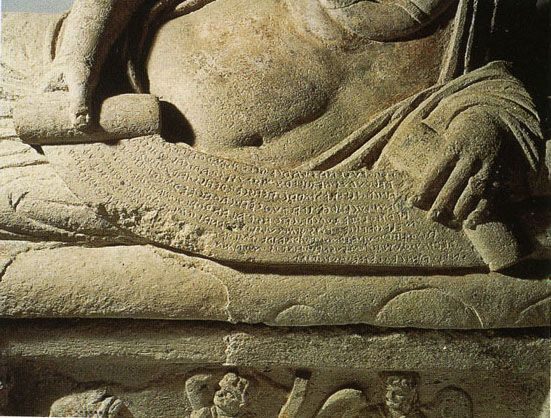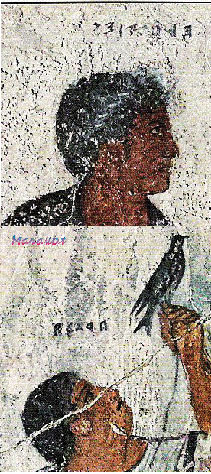Translation of short inscriptions.

Etruscan_Phrases
Translation of Short
Inscriptions (continued)
Scripts: MA, RA, VP, BT, LP, TB, FR, BB, BC, VC, ON,
OM, BE, BD
by
Mel Copeland
(from a work published in 1981)
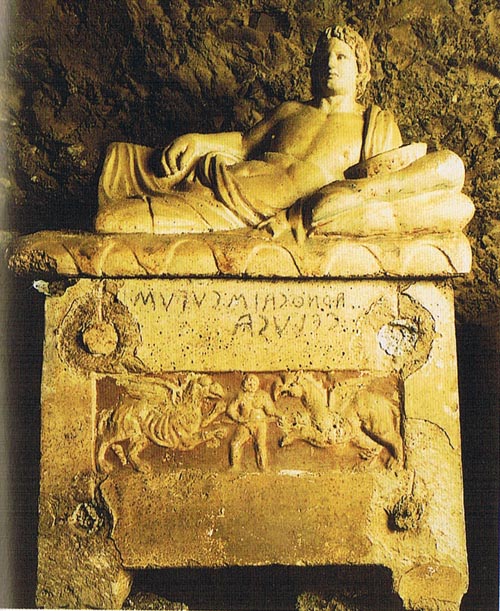
Script MA:
MA-1: ARN(ARNTH) CAIS :
CVPVS:
CFLVCA. [Translation: Arnth Caius / Gaius the
wealthy (L. copiosus-a-um, richly provided,
wealthy, abundant, of speech, eloquent; It.
copioso, abundant, copius; Fr. copieux, copius,
abundant, plentiful) or alternatively, in the jar
(It. coppo, m.) he is placed, stationed (It.
collocare) ] Note: the word CVPVS was read by
Borrelli and Targia as "Cutu" who say the "Cutu
were a family of freed servants who were
recognized by the nobles of the city. This urn is
from the same studio that produced that of the
'Volumnii.'" The word is either copus or copum.
The "S" in CAIS does not match with the "S" in
CVPVS, suggesting that the terminal letter may be
an "M." However, a colon / punctuation mark
follows the character and encroaches upon the
space required by the placement of a tag as in
. The "F" and "V" in CFLVCA are of
interest since they differentiate the "U" and the
"V" ; thus, CULOCA.
The scene with a man between two griffins suggests
the guarding of wealth. The griffin is a fabulous
beast with the head and wings of an eagle and the
body of a lion. The legend of the griffins is
Asiatic in origin and was widely known in Greece
through Aristeas of Proconnesus, who claimed that
griffins guarded hoards of gold from their warlike
and greedy neighbors, the Arimaspians. Herodotus
suggested that the story of these creatures
reached Greece through the Scythians. Griffins are
known to have been one of the stylized animal
forms in Scythian art.
Based upon the symbolism in the art of the urn,
the person was no doubt wealthy. We may be tempted
to think that he was a glutton, in CFLVCA, but it
is doubtful that family members would have placed
an epitaph suggesting a glutton (L. gula-ae,
throat; gulosus-a-um, gluttonous; It. gola,
throat, golosso, glutton) on this urn. He may have
been from a place such as Golosa, Liguria, in
northern Tuscany. Arnth is a rare word and often
ARNR (O
= R) is
read as Arnth. In this case the character used is
the target ,
the Greek theta.
Travertine urn from Monteluce, now in
Perugia, Museo Archeologico. 3rd century B.C.
Image from "The Etruscans," by Federica Borrelli
and Maria Cristina Targia, The J. Paul Getty
Museum, Los Angeles, 2003.
"Arnus Gaius the wealthy he is stationed."
Script RA
Script  RA,
Cinerary urn, 150-100 B.C., British Museum, "Ancus
the king." (Image: McManus, vroma.org)
RA,
Cinerary urn, 150-100 B.C., British Museum, "Ancus
the king." (Image: McManus, vroma.org)
The first word on this urn is difficult to read,
but the legend has been given as "Thana Ancarui
Thelesa." We need a better image, but a closer
examination of the image in Photoshop suggests the
following:
RA-1 A SINAANCA RVI
THELESA (
ELESA).
[Translation: by, at, from (L. a) Sina (Siena,
Italy) Ancus (L. Ancus-i) the king; a delight (L.
delicae-orum; It. delizia; Fr. délice)
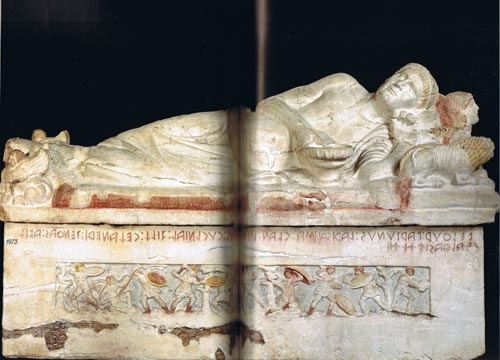
Script
VP: Sarcophagus of "Velthur Partunus," Circa.
480-320 B.C., Tarquinia, Museo Archeologico. Image
from "The Etruscans," by Federica Borrelli and Maria
Cristina Targia, The J. Paul Getty Museum, Los
Angeles.
VP-1: FELeR VR:
PARTV NVS : LARIS ALISA : CLAN : RAMeRAS : CVCLe NIA Le:
FILi (Filic) : CE
ANERI (KANERI, CHANERI) : TENeRAS : AFIL CE AL RAS :
![]() XXXII [Translation: The ship (L.
velum-i, a sail; It. vellero, Fr. voilier, sailing
ship) of the boundary, coast (L. ora-ae, f.) : to
part (L. partio-ire; It. spartire; Fr. partager) us,
ours (L. nos) : the gods (L. Lar, Laris, Lares)
Alisa; clan (L gens, tribus; It. tribu, Fr. clan,
m.) RAMeRAS or
RASeRAS:
Cocle (L. Cocles, Roman cognomen, esp. of Horatius Cocles, the Roman who
defended the bridge over the Tiber against Porsenna,
after the Romans expelled Tarquin the Proud in 510
B.C.) new (L. novus-a-um; Gr. nous, nea) there (le)
: successful, fruitful (L. felix-icis) to us (It.
ce) the Chaneri : you held, kept (L. teneo, tenere,
tenui, tentum [teneras]); he/she dwelt / had (L.
habeo-ere) to us (It. ce) to the (It. al) tribe (It.
razza; alternatively, Rasna, Rasne, Etruscans) 52
[years].
XXXII [Translation: The ship (L.
velum-i, a sail; It. vellero, Fr. voilier, sailing
ship) of the boundary, coast (L. ora-ae, f.) : to
part (L. partio-ire; It. spartire; Fr. partager) us,
ours (L. nos) : the gods (L. Lar, Laris, Lares)
Alisa; clan (L gens, tribus; It. tribu, Fr. clan,
m.) RAMeRAS or
RASeRAS:
Cocle (L. Cocles, Roman cognomen, esp. of Horatius Cocles, the Roman who
defended the bridge over the Tiber against Porsenna,
after the Romans expelled Tarquin the Proud in 510
B.C.) new (L. novus-a-um; Gr. nous, nea) there (le)
: successful, fruitful (L. felix-icis) to us (It.
ce) the Chaneri : you held, kept (L. teneo, tenere,
tenui, tentum [teneras]); he/she dwelt / had (L.
habeo-ere) to us (It. ce) to the (It. al) tribe (It.
razza; alternatively, Rasna, Rasne, Etruscans) 52
[years].
Note:
(1) RAMeRAS
might be RASeRAS, however the character on closer
inspection appears to be . Script Z709
carries the word RASR (L. rado, radere, rasi, rasum,
to scrape, shave, graze, to erase, hurt, offend).
RASeRAS may be RASeR AS (L. as-asgis, m. a whole
unit, divided into 12 parts). The Etruscans were
composed of a confederation of 12 cities.
(2) The Chaneri (KANERI)
are mentioned at BS17, a fresco in the "Tomb of the
Shields" in Tarquinia. They are referred to as
royalty.
Script BT

Script
BT:
BT-1 — SILiCI CEISIN
EISI
Fe [Translation: The
stone (L. silex-icis any hard stone, such as flint,
crag, rock, cliff); they ask for (L. quaeso-ere) you
denied their oath (L. eiuro and eiero-are) I sail
(L. veho-vehere)]
BT-5 — ESIC
Fe
Fe
CLEFSINAS [Translation: I
follow to the end, follow to the grave, keep up (L.
exsequor-sequi-sectus) of us (It. ce); I sail (L.
veho-vehere) I sail (L. veho-vehere) of Clusium
(Clusium-i, adj. Clusinus-a-um)]
BT-9 — TEIS
RVIS
RVTaS SS
V [Translation: the gods (L. deus
divus) of the kings (L. Fr. roi, m. L. rex, regis)
you whirl around, brandish (L. roto-are) SS ; O]
BT-14 — VMIS (end of
text, blank space) IPAILRCF
[Translation: you moisten, bedew (L.
umeo-[hu]-ere); Ipa (name, used also at Z1153,
Z1183, Z1227) of Ilircu (L. Ilyrii-orum?)]
BT-17 —
TI RVNIS
RENeS
TENAR
[Translation: to you; you watch, guard (It. ronda,
rounds; Fr. rond, adj. round, circular) you deny
(Fr. rener); to hold, possess (L. teneo, tenere,
tenui, tentum)]
BT-21 INE E SIS
SFA LENI
T [Translation: you swim, sail over?
(L. inno-nare); from (L. e, ex) to be willing, to
want (L. si vis, sis = si vis) he joins together (L.
suo, suere, sui, sutum) the linen thread, lines (L.
linea-ae, f.) T]
BT-27 ARILRCF
AF
TENARA [Translation: the altar, place
(L. ara, f.) Ilircu (Ilyrii-orum?) I carry off (L.
aveho-vehere-vexi-vectum) he shall hold (L. teneo, tenere, tenui, tentum)
BT-31 SE8ATE Le TRE
LVA
EI [Translation:
himself (L. se, sese) the prophet, bard (L.
vates-is) there you take up, pull (L. traho,
trahere, traxi, tractum); he expiates, atones for
(L. luo, luere, lui, luiturus) oh! (L. ai, oh, ei,
woe)
BT-37 IC AM SANaR VNIAM [Translation:
here, now (Fr. ici) I love (L. amo-are) to heal,
restore (L. sano-are) of the goddess Uni (Juno); I
love (l. amo-are)]
![]()
Script
LP, "Laris Pulena," Museo Archeologico,
Tarquinia, middle third century B.C.
This script
is difficult to read using the existing image and is
my first attempt. When I get a better image, I will
be able to improve this translation.
LP-1 MATRE _ _ _FVRNALAR TE RVI LAFA
ALR_ _ _ [ Translation: mother (L. mater)
or master (Fr. maître, master, patron) _ _ _oven (L.
furnus-i, m.): of the god (Lar, Laris, m.) your (L.
te) of the king (Fr. roi) he washes (L. lavo, lavare
or lavere, lavi, lautum, to wash, bathe, to moisten,
wet, to wash away) ALR_ _ _]
LP-4 TIV VRVS
_ _ _ _ CI RVMI SI PVLIS
LARIS AR
TH_ SIPE_ [Translation: Daily? (L. diurnus-a-um) you
plead (L. oro, orare, oravi, oratum [ores] _ _ _ _he
who/ those (L. qui, quae, quod; It. chi) of the
Romans (L. Roma-ae, f.) if (L. si) the sky, heaven
(L. polus-i, m.); the gods (L. Lar, Laris m.) of the
altar (L. ara-ae) : th_ often (L. saepe, often,
frequently)]
LP-14 FINITI HA AP RVR RAL SCASCE
CREATS
TARKII TIVS
PIA [Translation: you limited (L.
finio-ire, to bound, limit, enclose, restrain; to
define, determine, appoint, put an end to, conclude,
finish, esp. to finish speaking, or to die) he has?
(L. habeo-ere) after, from; I bedew (L. roro-are) I
scoff at (Fr. railler) you investigate / ordain (L.
scisco, sciscire, scivi, scitum, to investigate,
inquire; polit. to vote, ordain, resolve) the
election? (L. creatio-onis, f., choice, election);
of the Tarquins the divine (L. dius-a-um); the
godly, holy (L. pius-a-um)]
LP-26 RAM
LUCI
TIA
CFITA VRCFA
CARA Ce FARMI RI
PIT SVLV [Translation: I go back, return (L.
remeo-are); you set (L. loco-are, to place, put,
set, esp. to give in marriage, to contract for work
to be done); Dia (L. Dia-ae, f., the mother of
Mercury) he meets, unites with (L.
coeo-ire-li-ivi-itum, to go or come together,
assemble), the boundary (L. or) he assembles,
secures (L. coeo-ire-ivi-itum); alternatively he
unites with Orcus (Hades; L. Orcus-i, Orcus, the
infernal regions; transf. the god of the lower
world, death); he cares for (L. curo-are) here (Fr.
ici) the farms, farming (Fr. ferme, f., farm,
farming; It. fattoria, farm; L. agrigultura, res
rusticae, farming) of things (L. res, ri); I
appease? (L. pio-are) to make solitary (L.
solo-are)]
LP-39 M R_ _ IRI FIR EVR _ _ __ES
TALA ARC
STIV [Translation: (unreadable)
LP-48 MELE CRIA ICRE TIVS
CHIMV LVSI _ _ PRAI IPSI
MARS
CERIS
_
_ _ _ _ _ _ _ _[Translation: the honey, pleasantness
(L. mel, mellis) he produced (L. creo-are) of Icre;
god (L. dius-a-um); Chimos of the lights (L. lux,
lucis) _ _ before (L. prae) himself (L. ipse-a-um);
Mars?; of the goddess Ceres (L. Ceres-eris, Roman
goddess of agriculture; transf. bread, grain, corn)
_ _ _ _ _ _ _]
LP-59 FAR HA PVI AIRS TIV R_SRE – SI ATI [Translation:
grain, meal (L. far, farris) he has (L. habeo-are);
Truly! by Pollux! (L. poi) the air (L. aer, aeris,
m.) divine (L. dius-a-um) R_SRE (unreadable)
LP-70 (unreadable)
LP-80 (unreadable)
Lake Trasimene Bronze, Script TB

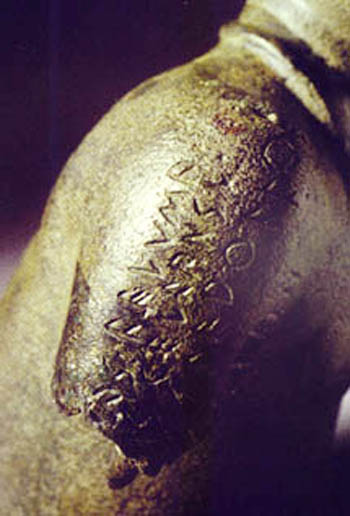
TB-1 ...SANS LeCFER [Translation: ...I cure (L. sano-are,
to heal, cure, restore) there (le) to assemble (L.
coeo-ire)] Note: This short inscription of a boy
holding a bird, Vatican Museum, found near Lake
Trasimene, carries two important words used in other
texts. CFER declines.
FR-1: EL RVI ES [Translation: her
(L. eius, illius; It. ella; Fr. elle, elles) king,
regent (L. rex, regis; It. re; Fr. roi) you are (L.
sum, esse, fui, futurus)]
FR-4 ARFEN (word unknown)
This image is a composite. Click on image for actual
Etruscan mural from the Tomb of Francoise.
Bronze, Boy with a bird, Script BB
Script BB-1 LAS FELVS
A [Translation: ...las (male divinity? See
script DM for lasa, female divinity) of the fleece?
(L. vellus-eris) or alternatively, handsome (L.
bellus-a-um)]
BB-3 ...S SE LARIS V_ [Translation:
...himself, itself (L. se, sese; It. si; Fr. se) of
the gods (L. lar, laris)..]
BB-5 ...E DOMO [Translation: ...from (L. e, ex) home
(L. domus-us, house, home; domo, from home) or
alternatively, to tame, conquer (L. domo, domare)]
BB-6 (unreadable)
Note: The characters "D" and "O" are rare.
Image from www.ou.ed
Script BC, Charon, ferryman of Hades
Script VC, vase from
Cerveteri, Vatican Museum
|
 |
|||||
| VC-7 AS VSTVX CACH (CAK or IAK) [Translation: a whole unit of 12
parts, possibly a weight, as a pound (L. as,
assis, m.) ostox, istox (unreadable,
possibly, L. iuxta, iuxtim, close by, near,
in like manner, equally, near to, just short
of) Bacchus, wine? (L. Iacchus-i, name of
Bacchus; meton. wine)] Thus, this seems to be a bottle, possibly for the Ati, a gens mentioned frequently in Etruscan texts, whose contents may have been one cup of sweet wine. |
||||||
 Script ON Script ON(Image from: http://www.personal.psu.edu (Pennsylvania State University), Erotic Art of Ancient Rome: via www.the-goldenrule.name) ON-1 TVTHE TVO [Translation: All , entire (L. total, entire (L. tutus-a-um; totius, toti; It. totale, tutto; Fr. tout; Welsh, tuath) two (L. duo-ae) ON-3 LOTUOI (LOTVOI) L. lotos-us, name of several African plants; L. lotus-i, f. lotos.; lotus-a-um, partic. from lavo. (L. lavo, lavare, or lavere, lavi, lautum, or lotum or lavatum, to wash, bathe, to moisten, wet, to wash away. Actors appear to be bathing someone. ON-4 KV _C ON-5 TVODEITCHES (TVODEIXES) L. duodecie(n)s, twelve ON-6 IU (IV) OE IUOT (IVOT) NOTYEIS F [Translation : Io OE? she helps, aids (L. iuvo, iuvat, 3rd person sing. present) Nycteis or probablyNyctimene. Io was an Argive girl loved by Jupiter and changed into a cow; Polydorus, Pentheus' successor and son of Cadmus, married Nycteus' daughter Nycteis, who bore him Labdacus. Dying while the child was still young, the king made Nycteus regent, to rule during Labdacus' childhood. Nycteus (king of Thebes) had trouble with his daughter Antiope who attracted the roving eye of Zeus who laid with her in the guise of a Satyr. When Antiope became pregnant she fled Thebes and took refuge in Sicyon where she married King Epopeus. Nyctimene was a daughter of Epopeus, king of Lesbos. When her father raped her, Nyctimene hid in the woods for shame. Athena pitied her and made her an owl, which does not appear in the daylight. ON-9 NOCTVA (L. noctua-ae, f. owl)? Note: If the word duodecies, twelve, appears in this image, it would be presumed that the vase carries twelve acts involving Dionysus. |
||||||
Script OM
Royal Ontario Museum, Script OM — This
script is on an "urn" located in the Royal Ontario
Museum, Toronto, Canada. The images were supplied
by Beth Knox, curator of antiq uities at
the Royal OntarioMuseum, to Rex Wallace,
Department of Classics, University of
Massachusetts, Amherts, MA. The images are
identified as Hayes G13 and G15. They are of two
cinerary urns of a cylindrical type common at
Chiusi. The inscription on G13 was painted in dark
red. (1)
uities at
the Royal OntarioMuseum, to Rex Wallace,
Department of Classics, University of
Massachusetts, Amherts, MA. The images are
identified as Hayes G13 and G15. They are of two
cinerary urns of a cylindrical type common at
Chiusi. The inscription on G13 was painted in dark
red. (1)
OM-1 —
[G13] FET NEPFIS CN AL SEK [Translation: The
feast, holiday (L. fetura-ae, It. festa; Fr. fête)
of Nepuis (name, related to L. nepos-otis,
grandson, nephew?) CN (initial Cn, for L.
Cnaeus-i) to, by the (It. al) six (L. secus,
indecl. sex) or alternatively rye (L. seges-etis,
It. segale; Fr. seigle)]
OM-6 — [G15] AA HA TEI FINAR
[Translation: AA (Maker's mark?) he, it has (L.
habeo-ere; It. avere, Fr. avoir) god (L. deus,
divus, di, divi, dea, diva; It. dio, dia; Fr.
dieu, dieux, deese) to finish, bind, limit,
enclose, apppoint, finish by speaking, or to die
(L. finio-ire)]
Royal Ontario Museum, Script OM,
G15:
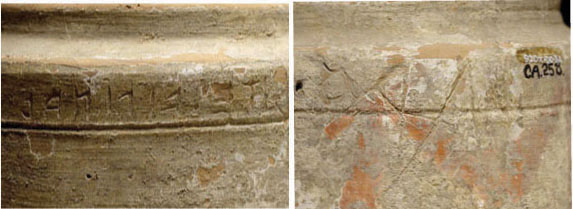
Script BD, Inscribed lead tablet, Pech Maho
(France).
BD-1 FE FVLS
IS You, to you, Enclit. or perhaps
(It. ve) you ordain (L. volo, velle, volui,
Ind. Pres. 2nd Pers. single vis, volas) he,
that person or thing (L. is, ea, id)
BD-4 SEKE KIS
NEF
8EKI he
cuts, parts (L. seco, secare, Conj. Pres. 3rd
Pers. Pres. secet ; It. seccare; Fr. sécher) who,
those, that (L. quis, quid) or not, and (L. neve
or neu) he excited, stirred up (L. vegeo-ere, 3rd
Pers. Single Perf. veguit)
BD-8 FENE LVIKA
VTAFV
he will come, arrive (L. venio, venire, Ind. Fut.
veniet; It. venire; Fr. venir) I expiated, loosed
(L. luo, luere, 1st Pers. Perf. lui) by which way,
whereby, as far as (L. ca) he was at leisure, rest
(L. otior-ari, 3rd Pers. Single Imperf. otiebat)
BD-11 8EI TFA KI
 FEN
FENMIS
Veii he would watch over (L. tueo-are, Conj. Pres.
3rd Pers. Single tueat) that which, who, whereby
(L. qui, quae, quod) I arrive, come (L.
venio, venire, Ind. Pres. 1st Pers. Single venio;
It. venire; Fr. venir); I deplore (L. miseror-ari,
Ind. Pres. 1st Pers. Single, misero)
BD-16 MATALIAMEL
Matalia (person's name) the honey, sweetness,
pleasantness (L. mel, mellis)
SIK 8INV
TVS thus, in this
way (L. sik) by the vinyard, wine (L. vinum-i,
Abl. Single -o) thine (L. tuus-a-um)
Script BE, Etruscan soldier's bulla
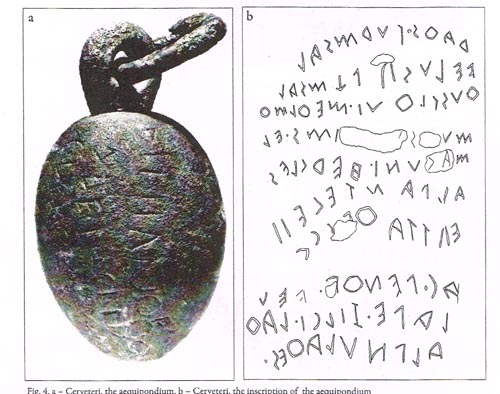
BE-1 RARS
TVRM SAL Rare (L rarus-a-um) the troop,
company (L. turma-ae) I am in good health (L.
salveo-ere, Ind. Pres. 1st Pers. Single salveo)
BE-4 FE LVS P CH M SAL you, to you? (It. ve, vi;
L. enclit., or, or perhaps) the light (L.
lux, lucis; Tocharian, luks; Lycian, luga;
Hittite, lukkai) a peace (L. pax pacis) healthy
(L. salus-utis, health, soundness, safety,
welfare, well-being, salvation)
BE-8 RVST Le RVI MERLvM
R (to next line)
BE-12 RvMVAS .......IMSEL
of the Romans (L. Roma-ae, Acc. Pl. -as) her
(L. illus, eius)
BE-14 ALPAN TELEII Alban (L.
Albanus-a-um) land, earth (L. tellus-oris, 2nd
Decl. Gen. Single-i)
BE-16 EAT TAREIC (C to next line)
likewise (L. eadem) Tarraco-onis, town in Spain
BE-19 CAC
PENeRI
FEL I hide (L. caeco-are, Ind. Pres. 1st Pers.
Single caceo); the provisions (L. Penarius-a-um,
2nd Decl. Nom Pl. -i) the great (fel)
BE-22 LAPE
SILCI
LAR from blemis,
disgrace (L. labes-is, 3rd Decl.
Abl. -e) the god (L. lars,
penates, household gods,
goddesses)
BE-25 ALB NVLA RES
Alp, name of a god? he was
unwilling, wished not to refuse
(L. nolo, nolle, nolui, Conj.
Imperf. 3rd Pers. Single nollet)
the matter(s), thing(s)
Notes:
(1) "Etruscan
inscriptions in the Royal Ontario Museum" by Rex
Wallace, WallaceENEWS5.pdf, 2006 http://etp.classics.umass.edu/
– | — | ♦
Launched 11.14.05
Upadated: 3.24.06; 5.12.06; 7.16.06;
7.27.06; 8.29.06; 8.30.06; 8.31.06; 10.12.06;
11.26.06; 12.28.06; 2.01.07; 6.06.09;
10.20.10; 12.28.10; 10.10.11; 06.28.13; 7.12.13
Copyright © 1981-2013 Maravot. All
rights reserved.
Copyright © 1981-2013 Mel Copeland. All rights
reserved.
.
